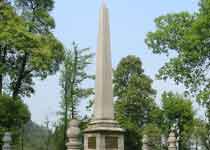Attration Category
Changsha Weather

Huang Xing was born in Shanhua County -- now Changsha County -- in Hunan Province. Originally named Huang Zhen, he was a famous democratic revolutionist in modern China. In 1902 Huang went to Japan for further study and returned to China the following year engaging in secret anti-Qing revolutionary activities. In 1904 he organized the Society for the Revival of China with two other famous democratic revolutionaries, Chen Tianhua and Song Jiaoren in Changsha. In 1905, together with Sun Yat-sen, Huang formed the United League of China in Tokyo, Japan. Since 1907, he attended, organized or directed the Zhennanguan Uprising, Yunnan Hekou Uprising, Guangzhou New Army Uprising, Guangzhou Huanghuagang Uprising and other anti-Qing armed uprisings in succession. After the Wuchang Uprising in 1911, Huang went to Wuchang and was elected general commander of the revolutionary army by temporary revolutionaries to lead wars against the Qing government armies in Hankou and Hanyan Districts. Huang then served as general commander of the army as well as chief of staff of the Nanjing interim government. During the Second Revolution in 1913, Huang was appointed general commander of the volunteer army against Yuan Shikai. He was defeated, however, and went into exile to Japan and then America. In 1916, Huang returned to China and died in Shanghai.
Situated in Liangtang of Haotang Village, Changsha County, Hunan Province, Huang's old residence is 15 kilometers away from Changsha City . Huang was born at the residence on October 25, 1874 and spent his youth there. The building was constructed during the reign of Tongzhi of the Qing Dynasty (1644-1911). It is an ordinary, single-storied, quadrangular structure that originally contained 48 rooms (only 12 remain today). On display are pieces of Huang's original furniture and stationary, including photographs and duplicates and photocopies of his writings.
Huang's tomb rests on Yuelu Mountain in Changsha City . On October 31, 1916, Huang died of illness in Shanghai; the following year, on April 15, Huang's body was relocated to Changsha, where a state funeral was held for him. Huang's tomb is located on open ground on top of the Yuelu Mountain, facing east. The tombstone is 10 meters high and has an inlaid bronze board with Chinese characters that mean "tomb for Mr Huang Xing". Surrounding the tomb are square stone pillars.


